This site is made possible by its sponsors.
Please visit them!

ala and alar groove - An ala is a winglike structure
or part in anatomy, such as
the external ear. It more commonly refers to the ala of the nose:
that membrane to the outside of each nostril. The alar groove
is a C-shaped edge
formed at the joining of the ala to the cheek.
Also see bust, philtrum, portrait, self-portrait, and septum.
alabastron - A container for perfumed oil that takes its name from alabaster, the material from which the original Egyptian examples were made. Greek artists adopted the Egyptian alabastron's form in the 600s BCE, but made the vessel in a variety of materials. Among the other types of Greek vases are the amphora, hydria, kantharos, krater, kyathos, kylix, lekythos, oinochoe, pelike, phiale, pinax, pithos, pyxis, and rhyton.
An example:
![]()
Greek (Seleucid or Ptolemaic), 2nd century
BCE,
Faience Alabastron, glazed
terra cotta, height
9 1/16 inches (23 cm), J. Paul Getty Museum, Malibu, CA.
Also see Greek art and Roman art.
ala of the nose - The flesh which surrounds the nostrils away from the center of the nose.
Also see alar groove, nasal septum, nostril, and philtrum.
à la colle - See distemper. A French term.
à la poupée - In intaglio, a means of printing several colors at one time by applying each color to the plate separately with a felt pad. A French term.
alar groove - The small valley behind each ala of the nose.
Also see glabela, nasal septum, nostril, and philtrum.
Albany slip - A slip clay that can produce a very dark brown glaze. Albany slip was mined near Albany, New York. Similar clays from other localities were used by early American potters in making stoneware.
Example:
Old electrical or telephone wire insulators, clear glaze over Albany slip.
Albany Slip is no longer being dug commercially. some potters have tried making substitutes, starting with other clay and adding colorants. Also see ceramics and pottery.
albumen print - A paper for making photographic prints, on which egg whites (albumen) coated the paper in order to increase its sensitivity, adding to the brightness of whites in the picture. This process was invented in the mid-nineteenth century by Blanquart-Evrard. Albumen prints were the state of the art in photography from 1855 to 1895, when gelatin provided a more stable effect.
Examples:
Matthew Brady (American, 1823-1896) Studio, Abraham Lincoln (1809-1865), 1864, albumen silver print, (carte de visite), 3 5/16 x 2 3/16 inches (8.5 x 5.4 cm), National Portrait Gallery, Smithsonian Institution, Washington, DC.

Mathews Brady Studio, Ulysses S. Grant (1822-1885), 1864, albumen
silver print, 4 9/16 x 4 3/4 inches (11.6 x 12.1 cm), National
Portrait Gallery, Smithsonian Institution, Washington, DC.
Mathews Brady Studio, Walt Whitman (1819-1892), c. 1870, albumen silver print, 9 7/16 x 7 3/8 inches (23.9 x 18.7 cm), National Portrait Gallery, Smithsonian Institution, Washington, DC.
Carleton E. Watkins (American, 1829-1916), Bridal Veil, Yosemite, c. 1865-1866, albumen print from collodion wet plate negative, Cleveland Museum of Art.

William Henry Jackson (American, 1843-1942),
Old Faithful, Wyoming, 1870, albumen
print, 20 3/16 x 16 3/4 inches (51.4 x 42.5 cm), J. Paul Getty
Museum, Malibu, CA. See nature.
William Henry Jackson, Currecanti Needle, Black Cañon of the Gunnison, before 1880, albumen print, Cleveland Museum of Art.
William Henry Jackson. Here's a link to searchable collection of over 25,000 photographs made for an American publisher between 1880 and 1920. It includes 900 large format photos by William Henry Jackson at the Library of Congress.

Frank Jay Haynes (American, 1853-1921),
Hell's Half Acre, Prismatic Springs,
late 1880s, albumen print from glass negative, Cleveland Museum
of Art.
alchemy - The ancient and medieval chemical practice especially concerned with the attempt to convert base metals into gold.
alcohol - A colorless, volatile,
flammable liquid, synthesized
or obtained by fermentation of sugars and starches and widely
used, either pure or
denatured, as a solvent and
in numerous manufactures as well as in intoxicating beverages.
Types include absolute alcohol, ethanol, ethyl alcohol (solvent
for shellac and some other
resins), grain alcohol, denatured
alcohol (inexpensive, because not taxed, and readily available,
this is the type artists use most.)
Denatured
alcohol is ethyl alcohol to which a poisonous substance, such
as acetone or methanol, has
been added to make it unfit for consumption. Also an alcohol,
although from other compounds, is methanol (also known as methyl
alcohol, wood alcohol), whose liquid and vapors are highly toxic.
Also see stain and stain removal.
algorithm - A rule, often mathematical, governing computer processes.
alias, aliased - Outside of its uses in computer technology and graphic design, an alias is a name that's an "also known as" name. Among criminals an alias is a false name.
In digital imaging, to alias is to sample data from an analog source, as one does in using a digital camera or a scanner. The edges of lines and shapes can be described as "aliased" when they are jagged instead of straight or smoothly curving. This is often the case because the resolution of the graphics file is too low. The graphic is then referred to as "aliased." The opposite of aliased is antialiased. The jagged edges of an aliased images are also called jaggies. Because most viewers see the jaggies as unpleasant, rarely is there justification for a graphic to reveal such digital coarseness.
Examples:

The word "Aliased" in an aliased
Arial font at 9 point size above an enlargement of that text.
This is the least legible of the three examples. Its poor kerning has resulted in a lack
of letter space between the
first two characters.

The word "Aliased" in an aliased
Arial font at 18 point size above an enlargement of that text.

The word "Antialiased" in an antialiased Arial font at 18
point size above an enlargement
of that text. This was produced with
black, white, and 15 levels of grayscale.
The resolution of this and all images on the Web are at the standard
72 pixels per inch. In a print
medium, if this text were
produced at the same size, and antialiased at a higher level
of resolution, the lettering could be extremely smoother. Take
a fresh look at the three examples with squinted eyes, or by
moving several feet away from your monitor.
Also in computer technology, an "alias" is an alternative name for an entity, such as a file or device. Users of Macintosh computers can assign aliases for files, which allows them to have icons or names for the same file in different folders. Windows provides the same functionality but does not use the term alias. UNIX also supports aliases, but calls them links or symbolic links. Whatever they are called, aliases make files more convenient to find or manipulate, and they can improve security by providing anonymity or deception.
Also see bit-mapped image and pixel.
alienation - A sense of isolation, depersonalization, disenchantment, estrangement, or powerlessness. Alienation has been considered an especially important issue during the twentieth century. It's often noted as being at the heart of modern dissatisfactions — especially of youths, women and racial minorities.
Also see angst, anti-art, existentialism, and issue.
align and alignment - In graphic design, to align is to line up type and other graphic elements on the same vertical, horizontal, or diagonal line. Alignment is the positioning of the characters in a line of type in exact juxtaposition with each other and with accompanying lines. It is also the positioning of printed pages in exact juxtaposition with each other when they register with adjacent pages, and with their reverse sides. Any mark made to assist in positioning images in order to align them is called either an alignment mark or register mark.
Also see angle, arrangement, bias, butt, direction, fold, moiré, order, sequence, and straight.
alizarin - Originally a bright red pigment, also called madder lake, made from madder, derived from the root of the plant Rubia tinctorum. Alizarin now generally refers to a pigment and a class of dyes derived from anthraquinone — synthetic coal-tar — and is used in the manufacture of blue, brown, green, red, violet, and yellow pigments.
Related resource:
alkaline - Any substance having a pH over 7.0. Alkaline substances are sometimes added to a material to neutralize acids or to form an alkaline buffer or reserve for the purpose of counteracting acids that might form in the future. A buffer might be added during manufacture or during the process of deacidification. Although the number of chemicals may be used as buffers, the most commonly employed are magnesium carbonate and calcium carbonate.
alkyd resins - Synthetic resins used in better-quality industrial house paints, enamels, and varnishes for over sixty years. In artists' materials, they have proven promising particularly as ingredients in oil paints.
An example of a work employing alkyd resins:
Red Grooms (American, 1927-), Looking Along Broadway Towards Grace Church, 1981, alkyd paint, gatorboard, celastic wood, wax, and foam core, Cleveland Museum of Art.
alla prima - A method of oil
painting in which the picture
is completed with the first application of paints to the entire
area, instead of being built up by layering. Italian for "the
first time."
(pr. ah-lah-PREE-'mah)
Also see abbozzo, coat, pochade, spontaneity, and technique.
alligatoring - A crackled texturing of a painted surface which resembles alligator skin. Though sometimes intended, it is usually regarded as disfiguring.
Also see fat over lean and finish.
all-over design or allover design - A repeated design that fills an entire area. All-over designs can be found on wallpapers and textiles, among other items.
Also see moiré.
all-over painting or allover painting - A painting surface which is treated as a continuous and indivisible surface, paint applied so that every portion receives equal attention. First used to describe the method of Jackson Pollock (American, 1912-1956), an Abstract Expressionist who, by distributing paint in a significantly uniform way, dripping and spattering it onto canvas spread on his floor, abandoned traditional means of composition.
Also see Color Field painting.
alloy - A metal produced by combining two or more metals — mixed together at the molecular level, in their molten state. Examples of alloys: brass, britannia, bronze, electrum, nichrome, niello, pewter and steel.
Also see aluminum.
allusion - An indirect reference to something or someone presumed to be familiar to the viewer, in order to increase the effect of an image. A citation.
Also see appropriation, audience, meaning, metaphor, perception, and subject.
Almohad style - An art style introduced into Spain by the Almohads, a Moroccan Berber dynasty, in the 1100s and 1200s.
Also see Islamic art and mosque.
altar - A table or other raised surface used as the place for religious ceremonies, which might include sacrifices made upon the altar.
Examples:

Greece, Attic, attributed to the Villa Giulia
Painter, Kylix, c. 470 BCE,
Classical, red-figure and
white-ground, terra cotta, height 2 7/16 inches (6.2 cm),
Metropolitan Museum of Art, NY. On the interior, a goddess stands
beside an altar, about to pour an offering from a phiale; on
the exterior, obverse and
reverse, Eos pursues Tithonos. See kylix.

German (Lower Saxony, Brunswick), Portable Altar and Ceremonial Crosses of Countess
Gertrude of Holland and Count Liudolf Brunon, c. 1040,
gold, cloisonné enamel, semi-precious stones, porphyry,
altar: length 26.7 cm, crosses:
height 24.3 cm, formerly part
of the Guelph Treasure, now in the Cleveland Museum of Art. See
Gothic.
![]()
Germany, Altar Cloth: Christ in Judgment and others,
second half of the 14th century, embroidery
of linen on linen, width
47 1/4 inches (120 cm), length
13 feet (396.2 cm), Metropolitan Museum of Art, NY. See textile.
Also see altarpiece and omphalos.
altered proportion - A technique used by an artist to change the size relationship of shapes in an artwork.
Also see miniature, monumental, and proportion.
alternating figures - Ambiguous
images which serve in the psychology
of perception to demonstrate
the way the mind habitually tries to achieve a coherent Gestalt.
These are often seen as optical
illusions. An example is a drawing
of a cube made with twelve
lines — allowing for two interpretations
of which edges are nearest and
farthest. This alternating figure is commonly called a "magic cube": the transparent cube in the center below. Which of its sides is nearest to you? Is it the one made solidly green on the cube to the left or is it the green side on the cube to the right, or is there no nearest side at all?

Here is a fully open-sided version produced with a high degree of realism. The two points where the linear edges must overlap have been purposely confused. The resulting figure produces an even more jarring figure-ground dilemma, likely to be interpretted as humorous or upsetting.
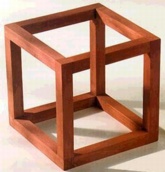
Op Art occasionally makes use of the phenomenon. Also see closure.
alternative spaces - Non-profit galleries run by and for artists, which proliferated in American and other cities in the 1970s as independent organizations, considered necessary in an era of increasingly diverse artistic issues, experimentation, commodification, etc. — the museums and commercial galleries were seen as providing exhibition opportunities both too few and too tied to commodification. Alternative spaces championed feminism and ethnic diversity by presenting work by women artists and artists of non-European descent. By the early 1980s the nature of such organizations had diversified. Recent art school graduates could still find storefront venues for their installation, conceptual, video and performance art endeavors, but some alternative spaces had evolved into highly structured institutions with large staffs and funding from foundations, and government entities such as the National Endowment for the Arts (NEA). The names most current for alternative space are "artists' organization" and "artist-run organization." Representing them in Washington, DC, is the National Association of Artists' Organizations (NAAO).
Amarna art - Egyptian art during the time of Pharaoh Akhenaten (1375-1358 BCE), who was a religious reformer. Amarna art is more natural, less stylized than earlier Egyptian art.
An example:

Egypt, Eighteenth Dynasty, Ay, Fan Bearer, c. 1360 BCE,
plaster on
limestone with polychrome,
Worcester Art Museum, MA.
ambiguity - Something open to two or more possible meanings; amphibolous. Alternating figures and other optical illusions may be helpful visual examples. In visual art, as in expository writing, ambiguity is usually something to be avoided, because it results in the audience's confusion. This might, however be an artist's intention, and perhaps involving irony or poetry rather than a straight communication of knowledge. Many creative works employ ambiguity quite effectively.
There are several art terms that, when not used clearly, result in ambiguity. One example is "pastel," when it is not made apparent whether the it signifies the medium or soft tints. Another is enamel.
Distinguish this word from the similar sounding "ambivalence."
Quote:
An obscure word for the fear of being misunderstood is "ambiguphobia."
Also see cryptic, definition, distort, and incongruity.
ambivalence - Mixed feelings. The sort of conflicting attitudes, such as love and hate, that one can feel toward a person, a thing, or an idea. Not to be confused with ambiguity.
Also see expression and communication.
ambrotype - A photographic process introduced in 1851-52, which quickly replaced the earlier daguerreotypes because they were cheaper and easier to view. It used weak collodion negatives which were then bleached and backed by a black background which produced the effect of a positive image.
Examples:
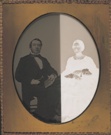
Mathew B. Brady (American, 1823-1896), Portrait of an unidentified couple, c. 1860,
full plate, oval ambrotype,
15.0 x 11.7 cm, George Eastman House, Rochester, NY. To show why a black background must be put behind an ambrotype, a black surface was placed only behind the left half of this double portrait. A white surface was placed behind the right half.

Isaac A. Rehn (
American, active 1840s-1870s), Family Group, 1855,
1/2 plate, oval ambrotype, mounted by Rehn's special process,
8.9 x 12.2 cm, George Eastman House, Rochester, NY.
ambulatory - A continuous aisle around a circular building, or a semi-circular aisle curving around the apse of a church behind the main altar. Developed during the Romanesque period, it made it easier for large religious processions to move about inside the church. The addition of the ambulatory led to the construction of radiating chapels, each with its small altar for worship. Also, it may refer to a covered walkway outdoors, as in a cloister.

American Academy of Arts and Letters (AAAL) - The American Academy of Arts and Letters is an American organization that fosters and sustains interest in literature, music, and the fine arts by identifying and encouraging individual artists. The primary way it does so is through awards and prizes. The Academy's programs also include exhibitions of art and manuscripts, staged readings and performances of new works, and the purchase of works of art and their distribution to museums. The members of AAAL, also called academicians, are two hundred fifty writers, composers, artists, and architects, all of whom are elected for life. As vacancies occur, the academicians nominate and elect new members. The AAAL's offices: 633 W 155th St, New York, NY 10032, phone 212-368-5900.
Also see academy, artists' organizations.
American art or art of the United States of America
- Art  by inhabitants of the United States of America.
by inhabitants of the United States of America.
People in the United States conventionally use "American" to mean "of the United States of America." Meanwhile, inhabitants of other countries in North and South America, the West Indies — the entire Western Hemisphere — have good reason to consider themselves "Americans" too. The author of ArtPage apologizes to that audience, hoping readers from these regions will understand that ArtPage is written from the point of view of its USA author, using the conventions of its predominantly USA audience. When referring to art associated with other American countries, ArtPage addresses them as Antiguan, Argentinian, Bahamian, Bolivian, etc.
See Pre-Columbian art, American Indian art, American Colonial art, African American art, Hudson River school, Realism and realism, Luminism, American Impressionism, Ten American Painters, The Eight, Ashcan school, Synchromism, Art Deco, Harlem Renaissance, American Scene painting, social realism, New Deal art, Abstract Expressionism, Pop art, Fluxus, Op Art, Minimalism, Earth art, Conceptual art, Neo-Geo, Post-Minimalism, architecture, arms & armor, ceramics, cinema, design, folk art, furniture, glass, illustration, photography, portrait, poster, sculpture, self-portrait, still life, tattoo, trompe l'oeil, vessel, and video, among many others.
Quote:
Related resource:

American Federation of Teachers (AFT) - This is an 830,000-member union of public and professional employees, including public and private school teachers, paraprofessionals and school-related personnel, higher education faculty and professionals, employees of state and local governments, nurses and health professionals. The union exits to serve the interests of its members as determined by democratic processes at the local, state and national levels. For the most part, those interests have to do with: establishing job security and fairness, usually through collective bargaining and legislative action; empowering AFT members to participate in efforts to uphold high standards for their professions and the institutions in which they work; disseminating information on professional issues and providing programs of training and professional development; working in coalition with other organizations to address issues that affect all working Americans, such as access to affordable health care, employment opportunity, social justice and much more.
Also see National Education Association (NEA).
American Gothic - A realistic, yet hard-edged style of painting associated with the works of Grant Wood (American, 1892-1942). Also the title of a famous painting by Grant Wood:
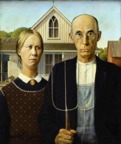
Grant Wood (American, 1892-1942), American Gothic, 1930, oil
on beaver board, 74.3 x 62.4 cm, Art Institute of Chicago.
Many versions of or reactions to American Gothic have been produced. Examples:

Gordon Parks (American, 1912-2006), American Gothic, 1942, photograph. Gordon Parks first worked in 1942-43 as a photographer under Roy Stryker in the Farm Security Administration (FSA).

Don Martin (American, 1932-2000), My
American Gothic, c. 1970, ink
and washes on paper.
Don Martin produced comic drawings primarily for Mad magazine
from 1955-1995.
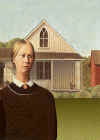
![]()
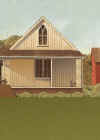
![]()
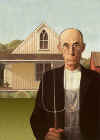
Unidentified artist, components of the original American Gothic are isolated in these three versions.

David Bradley (American, Chippewa / Lakota tribe, 1954), American Indian Gothic, 1983, color lithograph, limited edition of 50. See American Indian art.
![]()

American, Alien Gothic, c. 1985.

Lou Beach (American, contemporary), Yuppie
Gothic, c. 2002, illustration
for a book cover published by HarperCollins.
![]()

American design and manufacture, Beavis and
Butt-head American Gothic Magnet, c. 2003, printed and adhered
to a magnet, 3 x 2.5 inches.

Caty (American, contemporary art student,
at the age of 9), After American Gothic, crayon
on paper, Gainesville, FL.
Also by Grant Wood:
Grant Wood, The Ride of Paul Revere, 1931, oil
on Masonite, 30 x 40 inches
(76.2 x 101.6 cm), Metropolitan Museum of Art, NY. See history painting.
Related link:
Also see American Scene painting and Art Deco.

American Institute of Architects (AIA) - A professional organization for architects providing
resources for both practitioners and consumers. Its Web site — AIA Online
— covers stories of architecture
in the news and schedules of conferences as well as other events;
provides information about career planning, scholarships, fellowships,
awards, architecture schools, internships, and continuing education
programs; offers media resources such as a list of experts in
special fields and a synopsis of design trends; summarizes the
state of the marketplace with information about salaries, economic
forecasts, and architectural activity in different regions; also
includes a database of employment opportunities and project leads;
allows access to the searchable![]() catalog of the AIA library, a database
of products, a directory of member firms, and a search engine
for architectural design firms. The AIA also offers advice and
publications for the consumer who is hiring or working with an
architect.
catalog of the AIA library, a database
of products, a directory of member firms, and a search engine
for architectural design firms. The AIA also offers advice and
publications for the consumer who is hiring or working with an
architect.
American Luminism and American Luminists - See Luminism and luminists.
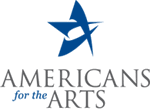 Americans for the Arts - Americans for the Arts is one of the USA's leading nonprofit organizations for advancing the arts. It is dedicated to representing and serving local communities in order to create opportunities for every American to participate in and appreciate all forms of the arts. Americans for the Arts was created in 1996 as a result of the merger between the National Assembly of Local Arts Agencies (NALAA) and the American Council for the Arts (ACA), two national nonprofit groups.
Americans for the Arts - Americans for the Arts is one of the USA's leading nonprofit organizations for advancing the arts. It is dedicated to representing and serving local communities in order to create opportunities for every American to participate in and appreciate all forms of the arts. Americans for the Arts was created in 1996 as a result of the merger between the National Assembly of Local Arts Agencies (NALAA) and the American Council for the Arts (ACA), two national nonprofit groups.
With offices in Washington and New York, and more than 5,000 organizational and individual members and stakeholders across the country, Americans for the Arts is focused on three primary goals:
1. increasing public and private sector support for the arts;
2. ensuring that every American child has access to a high-quality arts education; and
3. strengthening communities through the arts.
 To achieve its goals, Americans for the Arts partners with local, state, and national arts organizations; government agencies; business leaders; individual philanthropists; educators; and funders throughout the country. It provides extensive arts industry research and information and professional development opportunities for community arts leaders via specialized programs and services, including a content-rich website and an annual national convention.
To achieve its goals, Americans for the Arts partners with local, state, and national arts organizations; government agencies; business leaders; individual philanthropists; educators; and funders throughout the country. It provides extensive arts industry research and information and professional development opportunities for community arts leaders via specialized programs and services, including a content-rich website and an annual national convention.
Local arts agencies throughout the U.S. comprise this organization's core constituency. A variety of unique stakeholder groups with particular interests like public art, united arts fundraising, rural and small communities, state arts agencies, and emerging arts leaders are also supported. Through national visibility and local outreach, Americans for the Arts strives to motivate and mobilize opinion leaders and decision makers who can make the arts thrive in America.
 Americans for the Arts has been running rousing campaigns in the mass media, leading with such questions as "There's not enough art in our schools. No wonder people think Martha Graham is a snack cracker." And, ". . . No wonder people say 'Gesundheit' when you say 'Tchaikovsky.' " The two graphics shown here are samples of their work. Visit the Americans for the Arts, and take a good look at their varied and ongoing art advocacy.
Americans for the Arts has been running rousing campaigns in the mass media, leading with such questions as "There's not enough art in our schools. No wonder people think Martha Graham is a snack cracker." And, ". . . No wonder people say 'Gesundheit' when you say 'Tchaikovsky.' " The two graphics shown here are samples of their work. Visit the Americans for the Arts, and take a good look at their varied and ongoing art advocacy.
American Society for Testing and Materials (ASTM) - See ASTM International (American Society for Testing and Materials).
American Ten, The - See Ten American Painters.
American Watercolor Society
(AWS) -  The American Watercolor Society (AWS) is an artists' organization founded
in New York City in 1866. It currently has about 500 active members
and 2000 associates. The central activity of the AWS is its annual
juried exhibition. This exhibit
is open to all artists — members and non-members — worldwide.
Jurors award the painters of selected works more than $30,000
and a number of medals. Works
in all aquamedia are eligible, including watercolor,
acrylic, casein,
gouache, and egg
tempera.
The American Watercolor Society (AWS) is an artists' organization founded
in New York City in 1866. It currently has about 500 active members
and 2000 associates. The central activity of the AWS is its annual
juried exhibition. This exhibit
is open to all artists — members and non-members — worldwide.
Jurors award the painters of selected works more than $30,000
and a number of medals. Works
in all aquamedia are eligible, including watercolor,
acrylic, casein,
gouache, and egg
tempera.
Also see the National Watercolor Society (USA) and signature.
Amorite art - See Mesopotamian art.
amorphous - An anomalous, shapeless form, without crystalline structure. Amorphous materials have no sharply defined melting point, and surfaces of pieces that break have undulating surfaces like those of lumps of broken glass or of resin, both of which are examples of amorphous materials.
Example:
Louise Bourgeois (French-American, 1911-), Quarantania, 1941, seven pine elements on a wood base, 84 3/4 x 31 1/4 x 29 1/4 inches (215.3 x 79.4 x 74.3 cm), Whitney Museum of American Art, NY. See feminism and feminist art and sculpture.
Also see biomorphic form, concretion, and regular.
![]()
ampersand - A character
in lettering which stands for
"and."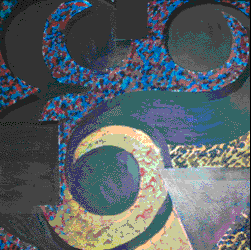
![]()
![]()
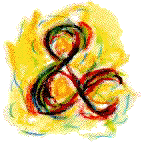
![]() Related
resources:
Related
resources:
Adobe.com's page about ampersands, their history and design.
Also see calligraphy, flourish, and typography.
amphibolous - Susceptible of two meanings; ambiguous; equivocal.
Also see cryptic, incongruity, irony, and pastel.
amphitheater - A kind of theater "in the round," a round or oval structure having a central stage or arena surrounded by tiers of seats rising gradually outward from it.
Example:

Roman,
Rome, Colosseum
(Flavian Amphitheater), 70-82 CE.
A vast ellipse in plan,
length 620 feet x width
513 feet (188 x 156 m), with
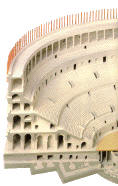 eighty external arcaded
openings on each storey, those on the ground floor forming entrances
from which the various tiers
of seats were reached.
eighty external arcaded
openings on each storey, those on the ground floor forming entrances
from which the various tiers
of seats were reached. See a cutaway view. The upper storey was added
222-224, around the top of which were sockets for 240 wooden
masts which carried a massive canopy (velarium). The façade's
entire height is 157 feet 6
inches (48.5 m). Each of the four storeys are pierced by arches, and have attached
three-quarter columns and
entablatures, Doric
in the first story, Ionic
in the second, Corinthian
in the third, and above these are pilasters
of Corinthian design, with small square window openings in alternate
bays. The wooden floor of the arena is an oval
287 x 180 feet, surrounded by a wall 15 feet high, behind which
were the podium, with the imperial throne, and seats for the
pontifex maximus, vestal virgins, senators, praetors, and other
officers of the state. Behind the podium rose the auditorium
seats for some 50,000-75,000 spectators, with corridors and stairs
beneath, while dens for wild beasts were under the lowest tier,
on a level with the arena. The seats (now removed) were in four
main horizontal divisions.
The construction of this amphitheater is notable for its combination
of materials, carefully
chosen for the purposes to which they were applied. The design
of this structure was made possibly because of the Romans' invention
of concrete, used primarily for
the foundations. Different types of concrete were utilized depending
on their need to be especially solid, or to be reduced in weight. Travertine
was used to face the exterior, for the piers
and arcades, tufa infill between piers for the walls of the lower
two levels, brick-faced concrete for the upper levels and for
most of the vaults, limestone
largely for floors, and marble
for seats, columns, and ornament.
Even in its current
ruined state, the Colosseum recalls the gladiatorial contests,
the naval displays, and the martyrdom of Christians which took
place within its walls before it became a medieval
fortress or was plundered to provide building materials for Renaissance
palaces and churches. Another view of the Colosseum.
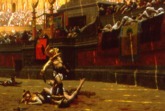
Jean-Léon Gérôme (French,
1824-1904), Pollice Verso (Thumbs Down), 1872, oil on canvas,
39.5 x 58.625 inches, Phoenix Art Museum. Gérôme
studied the architecture
of the Colosseum, along with other historical evidence in producing
this history
painting. To the right of the imperial throne, the vestal
virgins indicate their desire for the death of a defeated combatant.
Light streaming between sections
of canopy streaks across the floor and lower walls. Ridley Scott
(American, contemporary) has said that this picture inspired
his production of the movie Gladiator in 2000, starring
Russell Crowe and Joaquin Phoenix.
amulet - A piece of jewelry worn, most often as a ring, as a bracelet, or as a pendant to a necklace, as a charm against evil or injury. By contrast, a talisman is a piece of jewelry (often a pendant) promoting or attracting good.
Examples:

Egypt, Ram's-Head Amulet, c. 770-657 BCE,
Dynasty 25, late Dynastic period, gold,
1 5/8 x 1 3/8 inches (4.2 x 3.6 cm), Metropolitan Museum of Art,
NY.
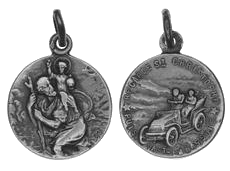
France, St. Christopher Medal, early 20th century,
British Museum, London. According to legend, St. Christopher
was a strong man who served Christ by carrying travelers across
a river, and on one occasion carried a small child who eventually
revealed his identity. Wearing such a medal
as this, many have believed, will protect them when travelling,
making it also an amulet. On the medal's obverse
is a traditional representation
of the saint carrying Christ. On the reverse
is an early automobile, along with an inscription
meaning, "Look to St. Christopher and travel strengthened."
The Roman Catholic Church officially withdrew sainthood from
St. Christopher in 1969.
Also see ex voto, fetish, medal, milagro, shaman, shamanism, and votive.
amyl
acetate - Derived from alcohol,
and used as a solvent for
some synthetic resins.
https://inform.quest/_art